Vietnam's transport backbone was in dismal shape. Each year the wet season added more potholes that were patched up in time to be reopened with the onset of the next wet season. There were few traffic police but the potholes were very effective speed humps.
I shot this video on a trial tour run by Paul Hole and I with a group of friends before we founded Travel Indochina.
Looking through my old videos from 1993 recently, I was amazed to see (posted above) just how quiet Highway 1 actually was back then.
What traffic there was made for a wonderful parade though. There were pre-1975 American military and non-military trucks and vans left over from the war that had been patched up over decades without any access to original spare parts. Functioning radiators were in short supply so large water tanks were fitted to the top of trucks and buses that cooled the engine and left a trail of water behind. There were regular water stations along the road.
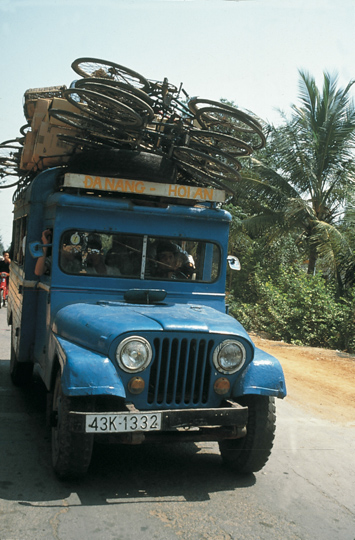
Photo: Mark BowyerTypical Highway 1 bus 1993.
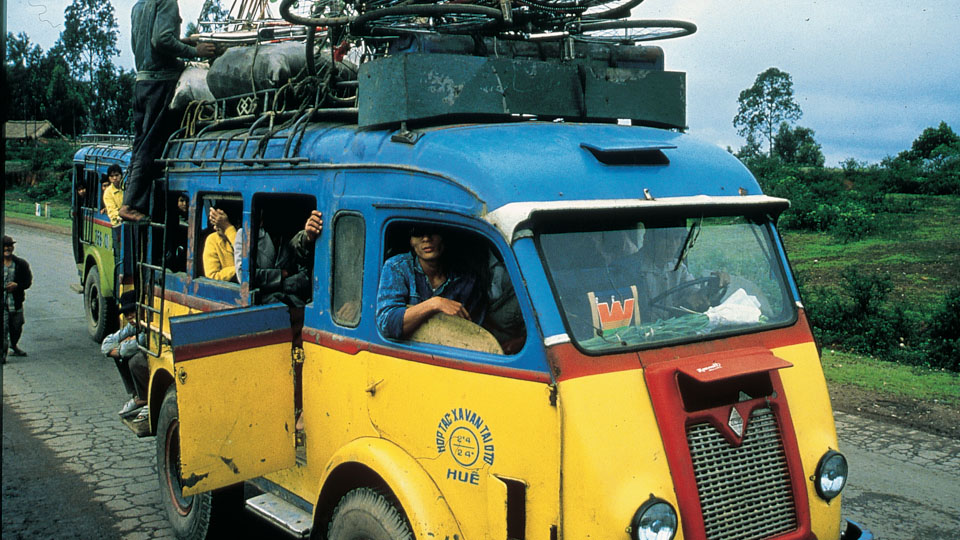
Photo: UnknownAn old French bus packed tight on Highway 1 outside Hue in 1993
The US trade embargo forbade any trade with Vietnam. And even if US parts were available, nobody could afford them let alone pay for them in hard currency. Improvised maintenance became the order of the day. And the Vietnamese became masters at it, managing to get longevity out of Fords and Chevies that US owners could only dream of.
The newer craft of the time, Russian and Chinese trucks and buses, looked as shabby, if not worse, than their much older American counterparts. Southern Vietnamese had never taken to things Russian nor Chinese, foisted upon them at the end of the war. They preferred the American and Japanese products of pre-Communist days. And they held on to whatever they had for decades. The Honda 67 motorcycle, approaching its 50th anniversary, is still in wide use all over southern Vietnam.
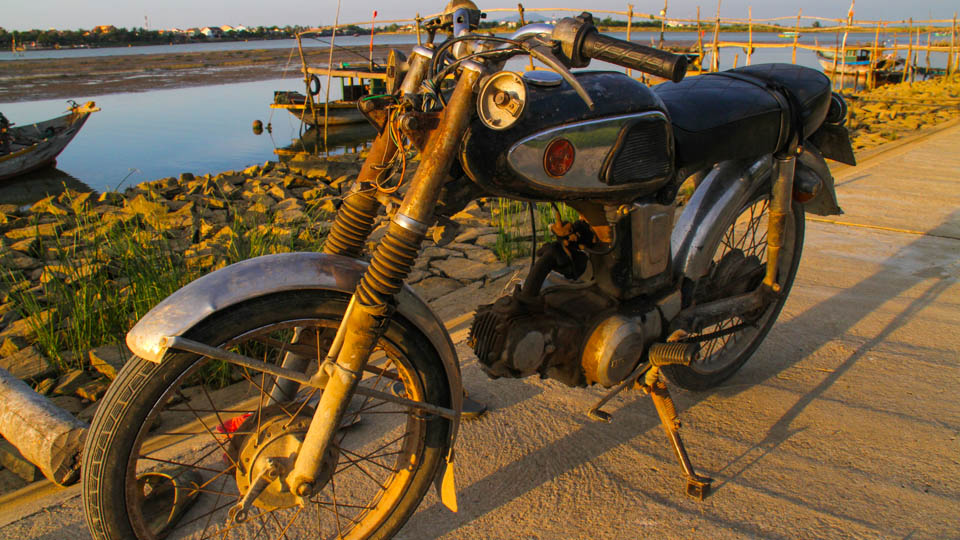
Photo: Mark BowyerThe Honda 67 carried Vietnam through the barren post war years. This old workhorse is on Cam Kim Island.
The journey between Nha Trang and Quang Ngai was the longest on the 17 day overland trip between Saigon and Hanoi. It was 10 - 12 hours on the road with few stops. The ride was spectacular - along a beautiful and completely undeveloped coastline, passing through hundreds of kilometres of deep green rice paddies.
The coastal route out of Nha Trang provided a spectacular start to the ride and our first stop was at Dai Lanh Beach - 80 kilometres north.
At the southern end of Dai Lanh beach stood the shell of an unfinished Russian resort. Before the demise of the Soviet Union a few years earlier, somebody must have belatedly spotted Vietnam's tourism potential. They picked a fine piece of beach for a resort. But it was all too late. When the Soviet Union collapsed, so did the money for the new hotel. Each year that passed saw wind and rain take a further toll on the shell. I'm pretty sure it's completely disappeared now.
As we headed further north through Tuy Hoa and towards Quy Nhon, attention turned to a library about Vietnam that I had put together for the group for reading during the long drives. Small libraries of 6 - 10 books became a feature of travelling with Travel Indochina at that time. I'm guessing Kindles and iPads have made the libraries redundant now.
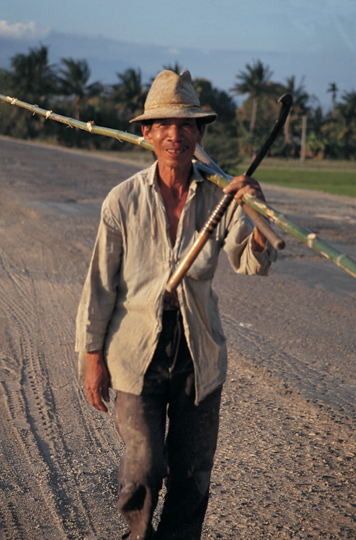
Photo: Mark BowyerHighway 1 was a mellow affair in 1993.
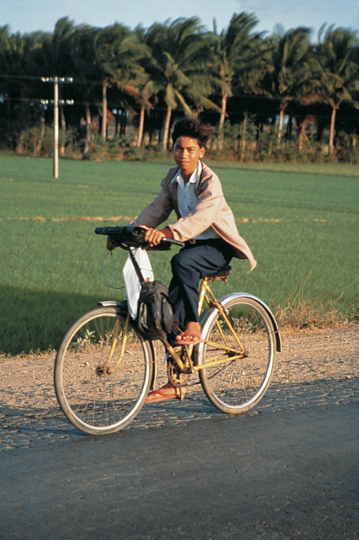
Photo: Mark BowyerHighway 1, Vietnam 1993
The library reflected the fact that most of what was written about Vietnam was about the war. Some war histories also provided some deeper historical background but for the most part, reading about Vietnam in 1993 was reading about the war.
Here are the books I recall from the first library:
The Quiet American - Graham Greene
Vietnam: A History - Stanley Karnow
A Bright Shining Lie - Neil Sheehan
The Ten Thousand Day War - Michael Maclear
Good Scent from a strange mountain - Robert Olen-Butler
Vietnam - Murray Hiebert
The Vietnam Reader - Walter Capps
Heroes - John Pilger
Getting the books into the country was quite an effort. There were no English-language bookshops. And books by foreigners about Vietnam were frowned upon. As Travel Indochina grew, with more tours and more tour leaders, keeping the libraries stocked became a quite a chore.
Vietnam's troubled relationship with books continues twenty years on. Bookshops here remain some of the most barren in the region - perhaps only better than those of North Korea. Next door in Cambodia, travellers have good bookshops stocked with a broad range of titles about Cambodia and other matters of international interest.
History, politics and even global affairs tend to be no-go zones in Vietnam's English-language bookshops. They're focused either on benign fiction, business or English language learning.
Your best chance for getting a decent book in Vietnam will be, as it was twenty years ago, from a street stall or street kids selling pirate copies of popular titles.
Even more sad than the absence of good English-language bookshops, is the fact that twenty years later, good writing about contemporary Vietnam is just as rare. Vietnam still frowns on those wishing to explore the country's contemporary history and culture as it does those wishing to sell engaging books. While academic research takes place, travellers and others interested in understanding contemporary Vietnam are left with slim pickings.
In addition to a library, Travel Indochina's first tours included video nights. In Nha Trang we showed the final episode of Stanley Karnow's TV series (based on the book), Vietnam a History - about the fall of Saigon. We also showed Dear America - letters from Vietnam and the French film Indochine. Indochine was the first major international motion picture to be shot in Vietnam and single-handedly put Halong Bay back on the tourist map.
Travel Indochina's early groups were mostly very receptive to the historical focus of the tours - and there was no avoiding the war. It was visible all around us. US Army Jeeps were the police car of choice in southern provinces. Piles of rusting scrap metal, mainly war junk, lined Highway 1. Old military parachutes were the favoured outdoor cover for restaurants and cafes. Bridges still broken from war-time bombing were everwhere.
Much of the war junk found use in the post-war economy. Motorcycle repairmen used bullet boxes to store their tools. Drink sellers at tourist sites used US Army ice boxes to chill their drinks. But the most useful leftovers were the metal panels used in the war to build makeshift airstrips. In peacetime, they made houses, fences, walls, trays and panels for trucks, pathways and bridges. There had been a lot of airstrips and those panels were everywhere.
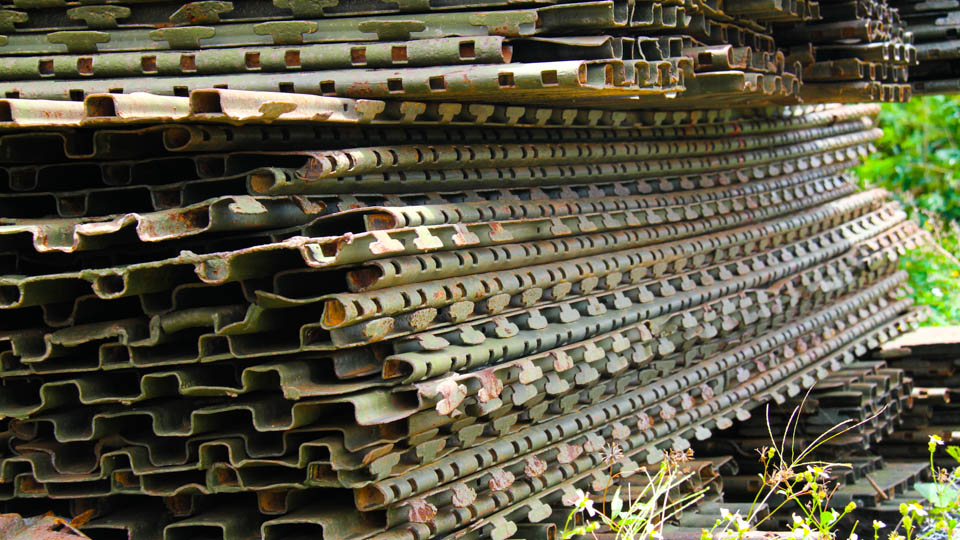
Photo: Mark BowyerThese metal panels made makeshift airstrips during the war. In 1993 they were used for houses, fences, bridges and more.
Our destination on day 6 of the New Vietnam was Quang Ngai - one of the poorest provinces in the southern half of Vietnam and an area with a proud history of resistance to French and later American troops. Quang Ngai also produced a number of high ranking Communist leaders including Pham Van Dong, who was Prime Minister of North Vietnam and then united Vietnam from 1955 to 1987 - an impressive innings.
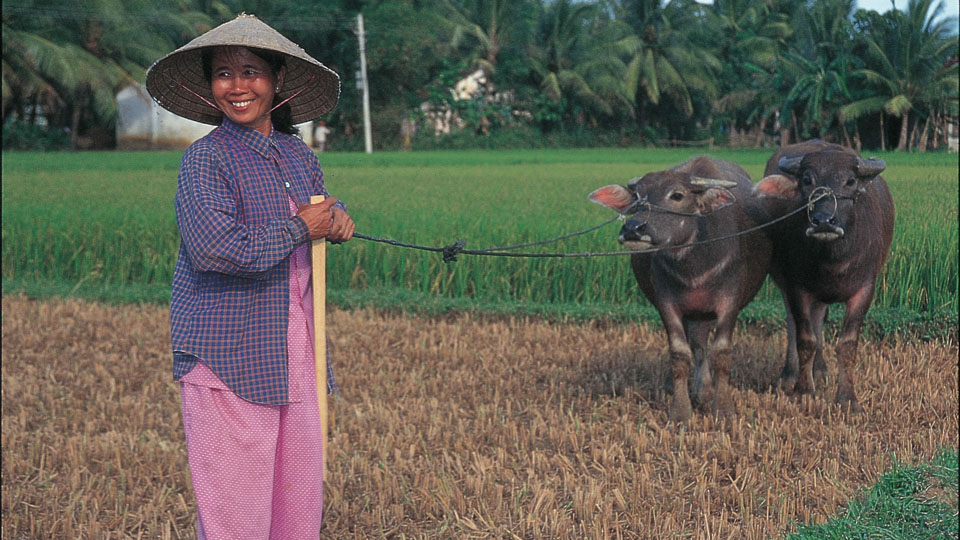
Photo: Mark BowyerHighway 1 scene, late 90s.
We were stopping in Quang Ngai because we couldn't get any further north in a day and because it was only a few kilometres from the My Lai memorial.
I'd gone to great lengths to organise the logistics of the first tour in advance, but the wheels fell of at Quang Ngai. I'd only visited the town once before and hadn't been able to make contact with the hotel I'd hoped our group would stay in. When we arrived, I jumped off the bus in advance of the group to organise check-in and discovered the hotel was full. We needed to find somewhere else to stay in what was the most hell-forsaken stop on the tour. With Travel Indochina's first real tour leader, Nicole Naylor (I was judiciously retired after 2 tours), I managed to bluff a little and headed to the nearby Song Tra Hotel on the river hoping things would work out better there.
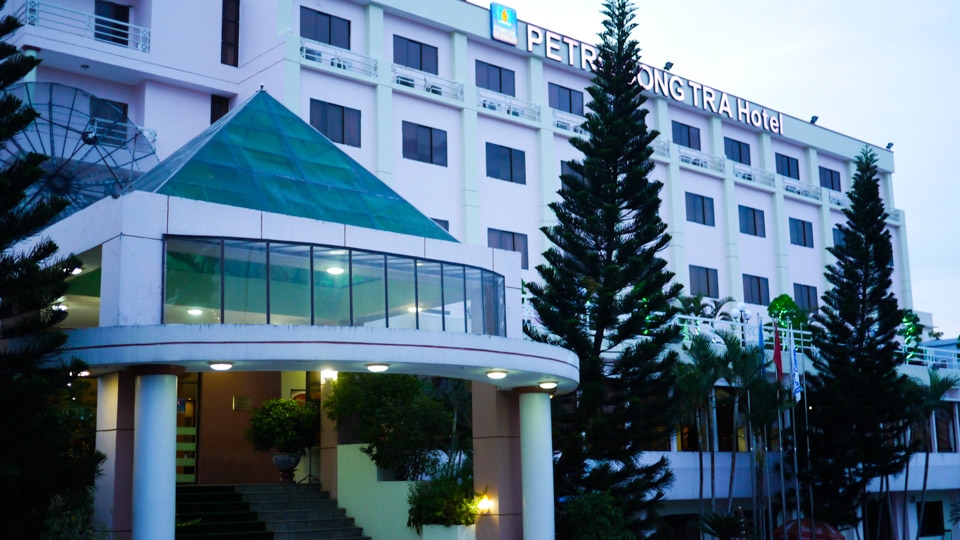
Photo: Mark BowyerThe Song Tra Hotel, Quang Ngai, in 2012. The incomplete death-trap of the 90s has had a major renovation.
It was our best option but it was a shocker.
Another relic of the Soviet Union's belated efforts to get a stake in Vietnam's soon to emerge tourism sector, The Song Tra was only slightly more complete than the shell we'd encountered at the beginning of the day on Dai Lanh beach. But it was operational, well sort of, and had rooms - so we snapped them up.
It wasn't until after we checked in that the health and safety disaster that was the Song Tra Hotel, was revealed. The stairways and walkways had no railings, leading to sheer drops to the ground. It was an abandoned construction project masquerading as a hotel. Hard hats were not issued.
The rooms weren't much better, with exposed electrical wires adding to the hazard of our one night stay.
The Song Tra's threats to life and limb made the general grubbiness of everything in the rooms - including the bedlinen - seem trivial. The group wasn't impressed. But they were here to experience Vietnam and the Song Tra certainly gave us all a memorable experience.
Somehow, the Song Tra survived on our tours for the next few months. Tour leaders from the time have plenty of war stories. My guess is that Travel Indochina's first few hundred travellers would still remember the Song Tra among their most memorable accommodation experiences. (It's since been rebuilt and I returned last year).
We escaped the Song Tra as quickly as possible the next morning and headed along a dirt track towards My Lai.
On March 16 1968, US forces massacred as many as 500 villagers at My Lai after suffering casualties in the area on previous days. It was the most publicised of many massacres during the war - despite efforts by the military to cover it up. Young journalist Seymour Hersh tenaciously pulled together the facts. Once news of the massacre became known in the US, support for the war eroded further.
For more on the My Lai Massacre, click here.
My Lai is down a narrow bumpy dirt road that in 93, saw very few motorised vehicles. There was a market across it that was covered by conical hat wearing women trading ducks, chickens and vegetables. As they packed up their wares to make way for our disruptive bus, they looked quizzically at the foreigners visiting a site they preferred to forget.
Our group was deeply moved by the My Lai visit. It was impossible not to be. The horror of the war for Vietnam's civilian population was remembered in a very simple memorial. The presentation by the young guide, Ms Huong, was unforgettable. She frequently became choked up with emotion recounting the events of that day 25 years prior when she was only a child.
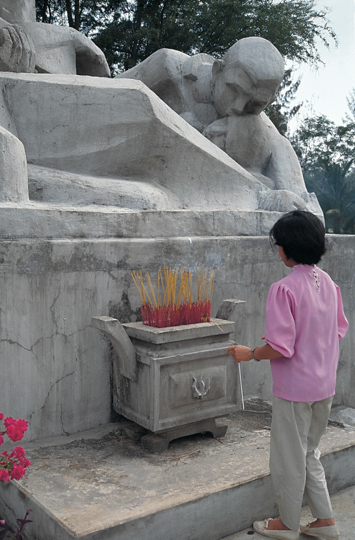
Photo: Mark BowyerMs Huong at My Lai, 1993
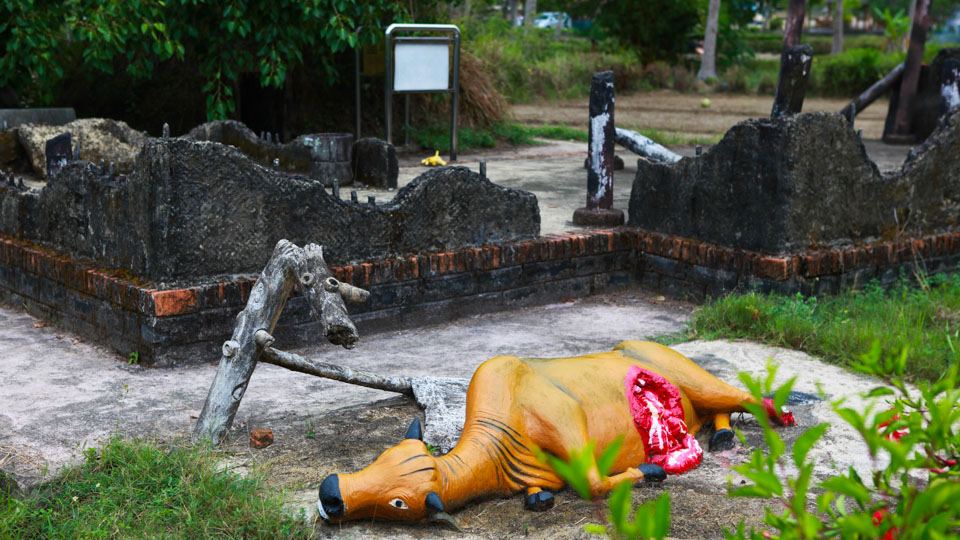
Photo: Mark BowyerMy Lai today. These concrete animals add nothing to the solemnity of the My Lai site.
My Lai has since had an "upgrade" that many of Vietnam's tourist sites have suffered. In a misguided attempt to add meaning and drama for visitors, the site, once empty apart from a socialist realist sculpture and mosaic, is now scattered with concrete replicas of slain farm animals and reproductions of parts of the village.
Needless to say, the new "attractions" detract from the solemnity of the site.
From My Lai we continued north past Hoi An towards Danang. I'll take up the story of Hoi An and Danang in 1993, in my next post.
Note:
I left Travel Indochina in 2006 and have had no involvement with the company since that time. It is now owned by a large international travel corporation.

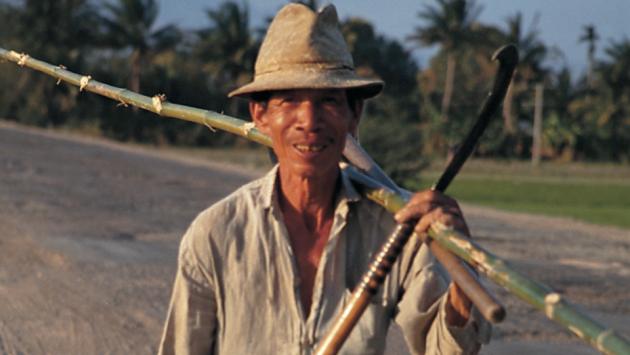



There are no comments yet.